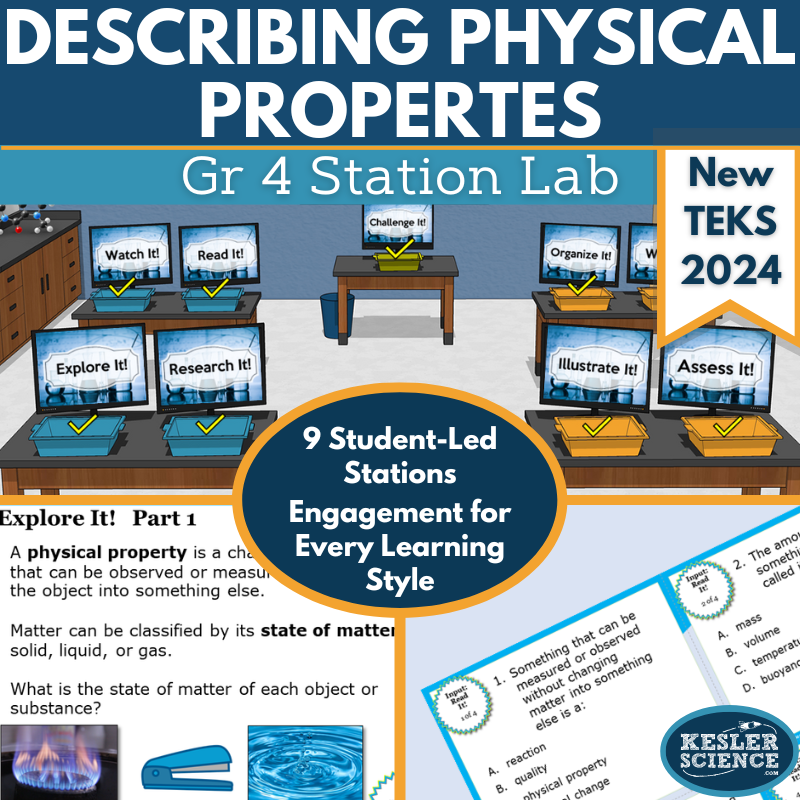
Describing Physical Properties Student-Led Station Lab - Grade 4, New TEKS 4.6A
Modular and student-led, this activity on naming, describing, and classifying physical characteristics of matter covers the chemistry 2021 TEKS 4.6A standard. It will keep your 4th grade class engaged and learning throughout this physical science lesson. These comprehensive materials will save you a TON of prep time while giving upper elementary students a chance to direct their own learning.
In this station lab, students will learn to describe the physical properties of matter and determine how the properties are used for classification.
DIFFERENTIATED, MODULAR, STUDENT-LED
Each station lab has nine differentiated activities that help the student create a personalized learning experience. In this student-centered approach, the teacher facilitates student learning rather than directing it.
The nine modular stations include all the signage, literature, resources, and task cards for the students to complete independently or in small groups. The stations may also require a few materials that you likely already have in your lab for the Explore It! station.
THE STATIONS
INPUT Stations offer multimodal ways to encounter new concepts about physical properties, including:
Explore It! – This station includes an activity that allows the student to connect information through application. In the digital version, students manipulate images and text in PowerPoint or Google Slides.
Watch It! – Students watch a short video at this station and answer questions about the properties of matter, including states of matter.
Read It! – At this station, students read a short passage about the characteristics of matter, including density, mass, temperature, magnetism, and volume, and answer questions about the reading and vocabulary terms. There are differentiated passages, now in English and Spanish, for readers that need a shorter, easier text.
Research It! – This station gives students facts, images, and graphs to connect with their learning about ways to describe and identify physical properties. Students will perform tasks and answer related questions on their lab sheet.
OUTPUT Stations give multiple ways for students to show what they have learned as they describe matter’s major physical properties.
Organize It! – The students work hands-on with manipulatives at this station. In the digital version, students manipulate images and text in PowerPoint or Google Slides.
Illustrate It! – At this station, the student sketches or draws out an example of at least three physical properties of matter. This visual learning activity allows for better recall and retention of new information.
Write It! – At this station, the students respond to short answer prompts that allow them to communicate their knowledge using complete sentences.
Assess It! – The students demonstrate their ability to describe the physical properties of matter and decide how the properties are used for classification, using a series of task cards with questions and a paragraph that uses vocabulary in context.
Bonus Station - Challenge It! – Early finishers and advanced students will love the extension activities in this station. Expand their learning through crosswords, games, and mini projects.
Can This Resource Be Used for Virtual Learning?
Yes! Station labs have been created so that students can use them on campus or in a virtual learning environment.
This is a finished product; it will be updated with formatting or corrections as needed. Future improvements and new features will be sold as a separate product.
Pickup currently not available
Terms of Use
Copyright © Kesler Science, LLC. All rights reserved by the author. This product is to be used by the original downloader only. Copying for more than one teacher, classroom, department, school, or school system is prohibited. Permission is never granted to enter Kesler Science materials into any form of AI for any purpose. This product may not be distributed or displayed digitally for public view. Failure to comply is
copyright infringement and a violation of the Digital Millennium Copyright Act (DMCA). Clipart and elements found in this PDF are
copyrighted and cannot be extracted and used outside of this file without permission or license. Intended for classroom and personal use ONLY. Multiple licenses are available for purchase by departments,
schools, or school districts. Contact support@keslerscience.com for more information.



















